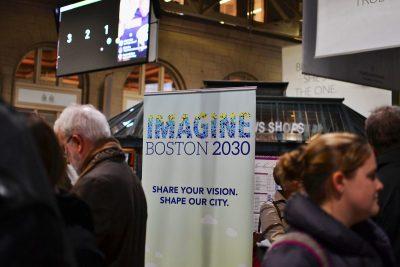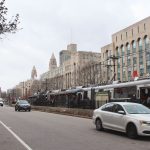
The City of Boston announced Friday it has reached a major milestone in its Go Boston 2030 transportation plan, with more than half of its proposed transportation infrastructure improvement projects currently underway.
The Go Boston 2030 plan identified 58 specific projects that are designed to make transportation safer, more convenient, more environmentally friendly and more accessible for residents across Boston’s neighborhoods, according to the plan. They range from improving access to the MBTA, building and improving sidewalks and bike lanes and redesigning city streets for greater efficiency.
Boston Mayor Martin Walsh first released the plan in 2017. To form the plan, the city collected more than 3,700 ideas submitted by residents and created a mayoral advisory committee of citizens and advocacy groups to determine the best course of action, according to Friday’s press release.
Richard Dimino, president and CEO of A Better City and co-chair of the mayoral advisory committee, said Walsh and his administration did a good job at developing and implementing the transportation plan.
“I have to give Walsh and Chris Osgood, Boston’s chief of streets, a lot of credit for moving forward with putting together one of the most substantive transportation plans in the city’s history,” Dimino said.
Among the city’s completed projects are a new bus-only lane on Washington Street as well as protected bike lanes throughout the city. There are currently 21 projects under implementation, 17 in design and 20 not yet started, according to the Go Boston website.
60 percent of Bostonians are now within a 10-minute walk of a transit station, up from 42 percent in 2017, according to the Go Boston 2030 website. Meanwhile, the city established its first Transit Team this year, which will work to improve regional rail travel.
Dimino said that there have also been challenges associated with the Go Boston initiative, especially in coordinating with the MBTA.
“One of those third parties that needs to step up is the MBTA, especially if Boston is going to become a transit-first city,” Dimino said. “We’re all hoping that at some point the T can move to being a 21st-century transit system.”
LivableStreets Alliance, a Boston transportation advocacy organization, is part of the advisory committee and is developing an accountability report on the city’s progress, to be released in March.
Louisa Gag, public policy and operations manager for LivableStreets, said while the progress shown on the new website is promising, there is still plenty of work to be done.
“We don’t think that [revealing] how many projects they started really tells the whole story,” Gag said, “That doesn’t speak about whether their pace is on track and it doesn’t speak to the quality of projects.”
Gag said LivableStreets’ accountability report will be an unbiased assessment that will include the whole story.
Andy Boudreau, 31, of Brighton, said he was a regular commuter, but hadn’t noticed any major changes so far. He said many of his frustrations relate to a convoluted bus schedule.
“For me, certainly certain bus connections don’t seem to link up correctly, like sometimes there’ll be a ton of one bus that’ll come by and then none of another,” Boudreau said. “It just seems very messy the way that it’s set up.”
Kayla Campbell, 18, of Roslindale, said the changes she’s seen have been mostly negative, such as the recent delays on the orange line.
“You can’t get from a certain place to another place,” Campbell said, “which is really aggravating.”



I am very happy that something is actually going to be done, However there are both still gridlocks, crowded buses and trains both in and around the immediate suburbs of the city! I really hope that the T can come up with a solid solution!
It is a lovely idea to add bike lanes and designated bus lanes but it also increases traffic and congestion on the streets as they are now narrower. Boston is an unusual city in that it has very few grid street layouts and that makes it much more challenging. I realize that we want to make the city less traffic centric but a lot of these changes will only exacerbate the issue, while providing limited benefit other than sound good headlines. We desperately need to focus on train/commuter train expansion. The state already has “shovels in the ground” to expand to New Bedford/Fall River. That is a start but we need infinitely more. The City should be focusing on that and not bike lanes which are good only during non winter months and have created incredible traffic jam issues.
Another obvious effort would be to stop building on every postage stamp piece of property in the city which increases density by orders of magnitude. All the bike lanes in the world will not make a difference. I get that we need housing – but exactly who are we building housing for? Yes, we get low income housing units (which btw are almost never in the building being built!!!) – the rest are very high end units in the millions of dollars. Certainly not middle class families who are being forced out of the city – ergo we need public transportation to the City to make getting to work accessible.